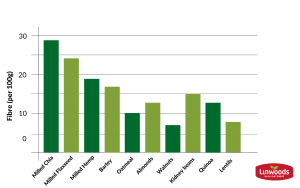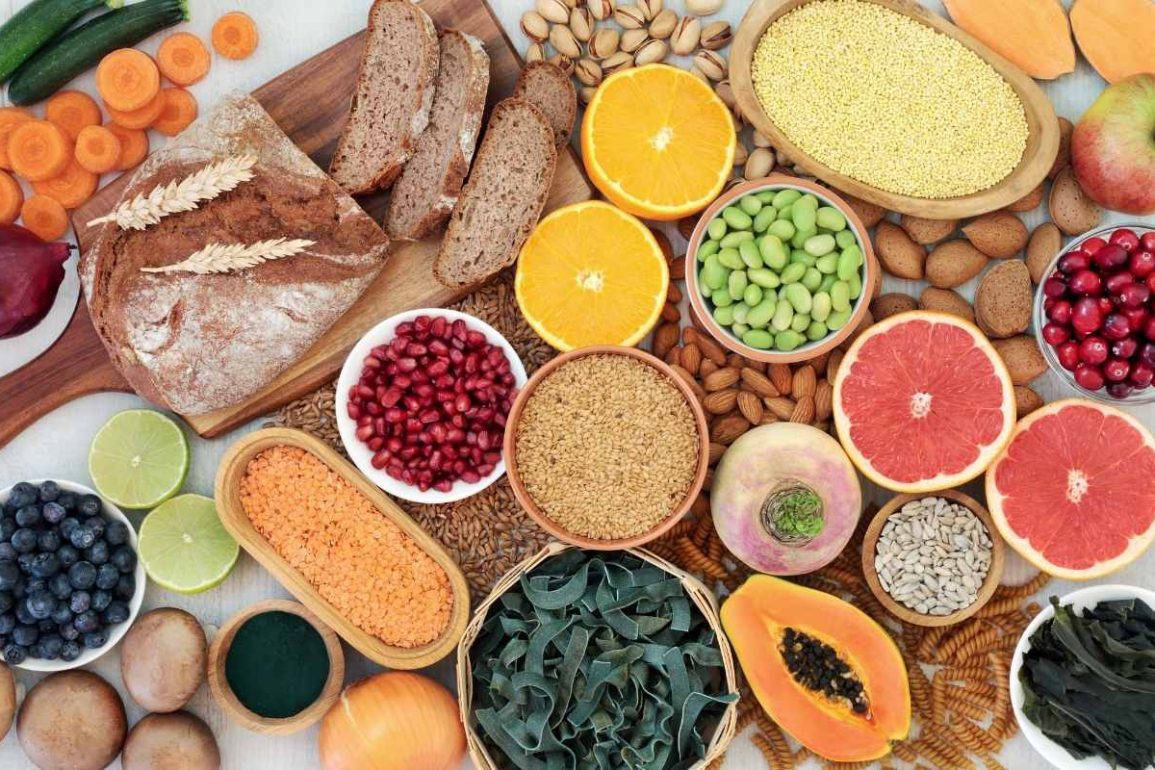Are you getting enough fibre? – Linwoods Health Foods are on a mission to educate on all things gut health, fibre, and digestion.
Our digestive system plays a major role in overall health and wellness transporting important nutrients throughout the body.
When your digestive health is impaired, you may experience many uncomfortable symptoms and adverse health effects.
One key component of good digestive health is fibre — and most people don’t eat enough!
What is fibre?
Fibre is a carbohydrate found in plant food sources such as fruit and vegetables as well as in nuts, seeds, beans, and whole grains.
Our bodies cannot digest fibre, and instead, pass it down through the gut into our large intestines where it works its magic to help keep the digestive system healthy.
There are two different types of fibre: soluble and insoluble. Both are equally important for digestive health and preventing diseases.
Soluble — draws water into the gut which helps soften stools and keep bowel movements regular. Soluble fibre will keep you feeling fuller and reduce constipation and has also been found to lower cholesterol and blood sugar levels.
Nuts, flax or chia seeds, beans, lentils, peas, and certain fruits and vegetables are all excellent sources of soluble fibre.
Insoluble — adds bulk to the stool which helps food pass more quickly through the stomach and intestines. Great sources of insoluble fibre include foods such as wheat bran, vegetables, and whole grains.
Why is fibre good for us?
Often referred to as natures scrubbing brush, fibre helps to clean out bacteria and other nasty build-ups in our intestines helping to reduce the risk of diseases
Daily fibre intake keeps bowel movements soft and regular, preventing constipation and can be used as a food source for good bacteria in your large intestine.
Fibre also has a turbo-charge-like effect on your intestines, making them work faster than normal. This quicker movement of food through the body signals that you’re fuller, which can also help to aid weight loss.
How do I know if I’m getting enough fibre?
Although fibre is essential to your gut and overall health, most people struggle to get anywhere near the recommended daily amounts (RDA) of 30 grams for adults and 15 grams for children.
Six of the most common signs indicating that you’re not getting enough fibre include:
You are constipated
Finding it difficult to do your number 2’s? A low fibre intake is most likely the cause. This restricts the amount of undigested material passing through your large intestine and stool bulk becomes lessened.
Dietary fibre increases the weight and size of your stool and softens it. A bulky stool is easier to pass, decreasing your chance of constipation and haemorrhoids.
You get hungry soon after eating
The more fibre you eat, the longer it takes for your body to digest, helping curb appetite.
High cholesterol
When your fibre intake is high it lowers the amount of bad cholesterol (LDL) that gets absorbed into the bloodstream.
Feeling tired and sluggish
A diet low in fibre causes spikes in blood sugar levels and the subsequent crashes that follow resulting in depleted energy levels.
It is important to include a variety of high-fibre foods regularly when trying to up your intake to contribute to a healthy balanced diet.

Easy ways to increase your intake include:
Add nuts or milled seeds to your breakfast cereal or sprinkle over yoghurt
Add beans or lentils to soups
Have a serving of fresh fruit and vegetables with every meal
Try snacking on nuts throughout the day
Substitute white bread for wholemeal or granary bread
Linwoods Milled Flaxseed can naturally enhance the fibre content of any meal. It is perfect for adding to your breakfast every day.
Taking a fibre supplement or adding in some fortified foods can really help if you struggle to hit the daily recommendations however naturally occurring fibre in foods should always come first.
As with anything, you can have too much of a good thing and it’s no different with fibre. Too much in the diet can cause symptoms of bloating, gas, and constipation.
But, on the off chance that you do experience any of these symptoms, especially when transitioning to a high-fibre diet, increasing your fluid intake, and exercising are great ways to relieve discomfort.
The bottom line
Dietary fibre is essential to our overall health and well-being. Research suggests a high-fibre diet can reduce the risk of many health conditions, including cardiovascular disease, type 2 diabetes, and gut issues. But most people don’t consume enough.
Here is a delicious, healthy recipe to entice you:
Acai Bowl
Serves 1
Ingredients
- 1 x 100g pack frozen acai
- 1/2 cup frozen blueberries
- 1/3 cup frozen raspberries
- 1 banana frozen
- 1/4 cup almond milk
- 1 tbsp Linwoods Milled Flaxseed
Toppings
- Banana
- Blueberries
- Raspberries
- Granola
Method
- Place all the acai bowl ingredients in a food processor or blender and blend until completely soon.
- Scoop into a bowl and then top with chopped banana, kiwi, berries, and granola.
Poppy Watt


